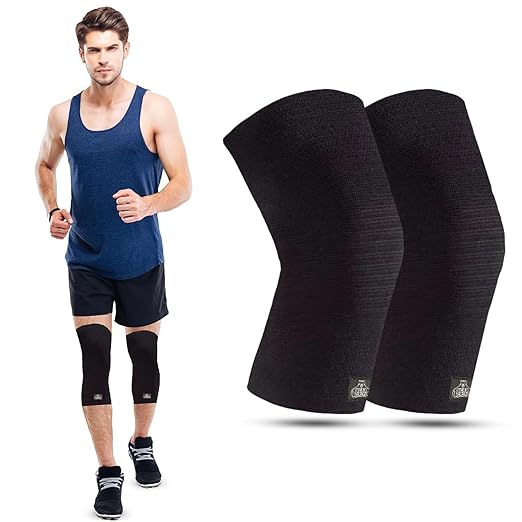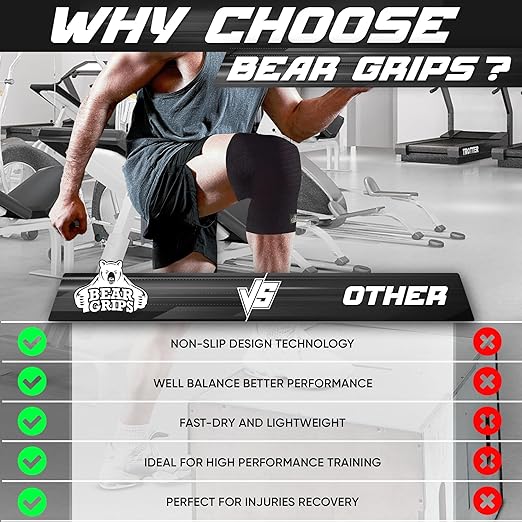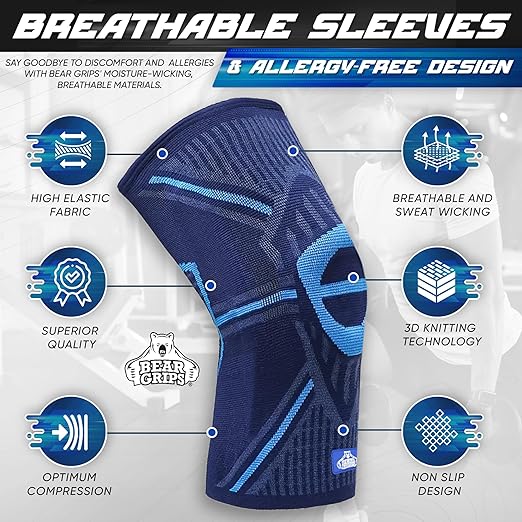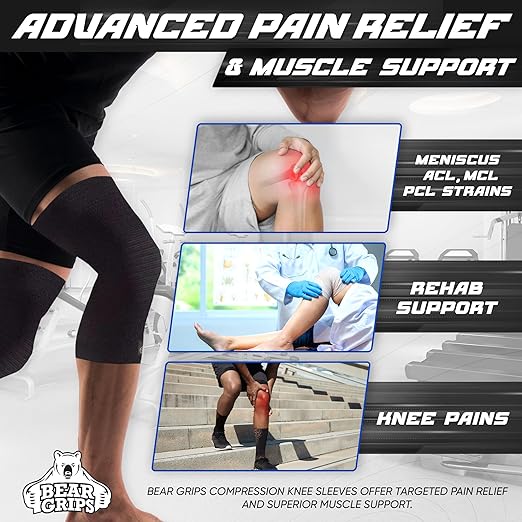
How to Properly use Knee Wraps? A Complete Guide
Share
Welcome to our comprehensive guide on how to effectively use knee wraps in your workouts. Knee wraps are an essential tool for weightlifters and powerlifters, offering numerous benefits such as enhanced performance and injury prevention. In this article, we will explore the proper techniques for wrapping your knees, discuss the benefits of using knee wraps, and provide insights into the different workouts where knee wraps can be advantageous.
When it comes to wrapping your knees, it's crucial to learn the correct techniques to ensure optimal support and comfort during your lifts. The New Zealand Powerlifting Association recommends simple and effective wrapping methods that anyone can follow. Before you start wrapping, make sure to roll the wraps tightly for easier handling and a snug fit.
The basic wrapping technique involves starting from behind the knee and below the patella, providing essential support to the knee joint. Two popular wrapping styles are the simple straight wrap and the crossover wrap. The simple straight wrap is the easiest to execute, while the crossover wrap offers more support and prevents the patella from shifting during squats.
By mastering proper wrapping techniques, you can significantly improve the effectiveness and safety of your squatting exercises. For advanced lifters, there are also techniques that involve using a partner for additional support.
In terms of benefits, knee wraps provide extra compression and support for the knee joint during heavy sets of exercises like squats, leg presses, and Olympic lifts. They help alleviate knee discomfort temporarily and can even enhance your performance. However, it's important not to overuse knee wraps for lighter loads, as this can weaken your tendons and muscles over time.

Choosing the right knee wraps is essential for maximum effectiveness and durability. Look for wraps that offer a snug fit, durable materials, and adjustable tension. The length of knee wraps typically ranges from 72 to 82 inches, with 72 inches being sufficient for most users.
To avoid common mistakes, ensure you maintain proper tension throughout the wrapping process and avoid wrapping too tightly, as it can cause circulation issues and compromise your technique.
Now that you have an overview of the techniques, benefits, and workouts associated with knee wraps, you're ready to take your training to the next level. Get your hands on recommended knee wraps, such as the Bear Grips Knee Wraps, and start experiencing the difference they can make in your workouts!
When and How to Use Knee Wraps: Tips for Optimal Performance
Knee wraps are an invaluable tool for weightlifters, providing essential support and compression to the knee joint during intense workouts. Knowing when and how to use knee wraps can greatly enhance your performance and help prevent injuries. Here are some tips to optimize your knee wrap usage:
- Use for Heavy Sets: Knee wraps are most effective when used for heavy sets of exercises like squats, leg presses, and Olympic lifts. Their extra compression and support can help you lift heavier weights with greater stability.
- Avoid Overuse: While knee wraps are beneficial for heavy loads, avoid relying on them for lighter loads. Overusing knee wraps can weaken your tendons and muscles over time. Reserve their usage for demanding workouts.
- Proper Wrapping Technique: Learn and master the proper wrapping technique to maximize the benefits of knee wraps. The spiral method is a popular choice, but there are other wrapping techniques to explore. A well-wrapped knee provides optimal support and stability.
- Starting Position: Start with your leg extended and place the knee wrap just below the kneecap. This ensures that the wrap covers the key areas that need support during your movements.
- Create an "X" Pattern: Create an "X" pattern with the knee wrap, spiraling it up to cover the entire knee. This pattern helps distribute tension evenly and provides comprehensive support to the knee joint.
- Appropriate Tension: The knee wrap should be tight enough to provide support but not so tight that it restricts proper movement. Finding the right balance of tension is crucial for optimal performance.
- Optimal Weights: Use knee wraps when lifting weights above 80-85% of your one-rep max. This ensures that you are getting the most out of the benefits provided by the knee wraps.
- Pain Relief: In addition to extra support, knee wraps can provide temporary pain relief and alleviate knee discomfort during intense workouts. They can help reduce strain on the knee joint.
- Choose the Right Knee Wraps: Look for knee wraps that offer a snug fit, durable materials, and adjustable tension. The right knee wraps should provide comfort, support, and a secure fit.
By understanding when and how to use knee wraps effectively, you can enhance your performance, protect your knees, and optimize your workouts. Remember to use knee wraps responsibly and in conjunction with proper form and technique to maximize their benefits.

Choosing the Right Knee Wraps and Common Mistakes to Avoid
When it comes to selecting the perfect knee wraps for your workouts, there are a few key factors to consider. First and foremost, the length of the knee wraps is important. Most knee wraps range from 72 to 82 inches, with 72 inches being sufficient for most users.
Additionally, the width of the knee wraps plays a crucial role in providing adequate support. Look for knee wraps that are at least 3 inches wide to ensure optimal stability and protection for your knees.
Another important aspect to keep in mind is the thickness of the knee wraps. Choose knee wraps that are at least 0.2 inches thick to maximize support and compression.
When it comes to the material, elastic knee wraps are preferred as they allow for proper tension and energy storage, enhancing your performance and protection during heavy lifts.
Furthermore, consider knee wraps with velcro straps, as they offer easier and more secure fastening compared to wraps without straps.
Reinforced stitching is also an important feature to look for, as it ensures durability and prevents fraying, allowing your knee wraps to withstand the rigors of intense workouts.

Lastly, consider knee wraps that come with a warranty or guarantee for added peace of mind, ensuring that you are investing in a high-quality product.
Common mistakes to avoid when using knee wraps include failing to maintain tension throughout the wrapping process and wrapping too tightly. These errors can lead to circulation issues and compromise your technique. Proper tightening and technique are crucial for reaping the full benefits of knee wraps while avoiding potential drawbacks.
By following these guidelines and avoiding common mistakes, you can choose the right knee wraps to support your workouts effectively and optimize your performance while keeping your knees safe and injury-free.
Want to improve your workout? Grab your knee wraps from Bear Grips today!!!
Shop at AMAZON.COM now!
FAQ
What are the benefits of using knee wraps?
Knee wraps provide extra compression and support for the knee joint during intense weightlifting, enhancing your workouts and preventing injuries.
What are the basic wrapping techniques for knee wraps?
The basic wrapping techniques for knee wraps include the simple straight wrap and the crossover wrap. The simple straight wrap is the easiest but less comfortable during squats, while the crossover wrap provides more support and prevents the patella from shifting during the squat.
How do I properly wrap my knees with knee wraps?
To properly wrap your knees with knee wraps, start from behind the knee and below the patella, ensuring support for the knee. Roll the wraps tightly before starting for easier handling and a snug fit. Use the spiral method or other wrapping techniques, starting with your leg extended and placing the wrap just below the kneecap. Create an "X" pattern with the wrap, spiraling it up to cover the entire knee. The wrap should be tight enough to provide support but not restrict proper movement.
Are there more advanced wrapping techniques for knee wraps?
Yes, more advanced wrapping techniques for knee wraps are available, including techniques using a partner for additional support.
What exercises should knee wraps be used for?
Knee wraps should be used for heavy sets of exercises like squats, leg presses, and Olympic lifts.
Are knee wraps suitable for lighter loads?
Knee wraps should be avoided for lighter loads, as overusing them can weaken the tendons and muscles over time.
What should I consider when choosing knee wraps?
When choosing knee wraps, look for wraps that offer a snug fit, durable materials, and adjustable tension. The length of knee wraps typically ranges from 72 to 82 inches, with 72 inches being sufficient for most users. Choose wraps that are at least 3 inches wide to provide adequate support and at least 0.2 inches thick for optimal support and compression.
What are common wrapping mistakes to avoid?
Common wrapping mistakes include failing to maintain tension throughout the wrapping process and wrapping too tightly, causing circulation issues and compromising technique.


